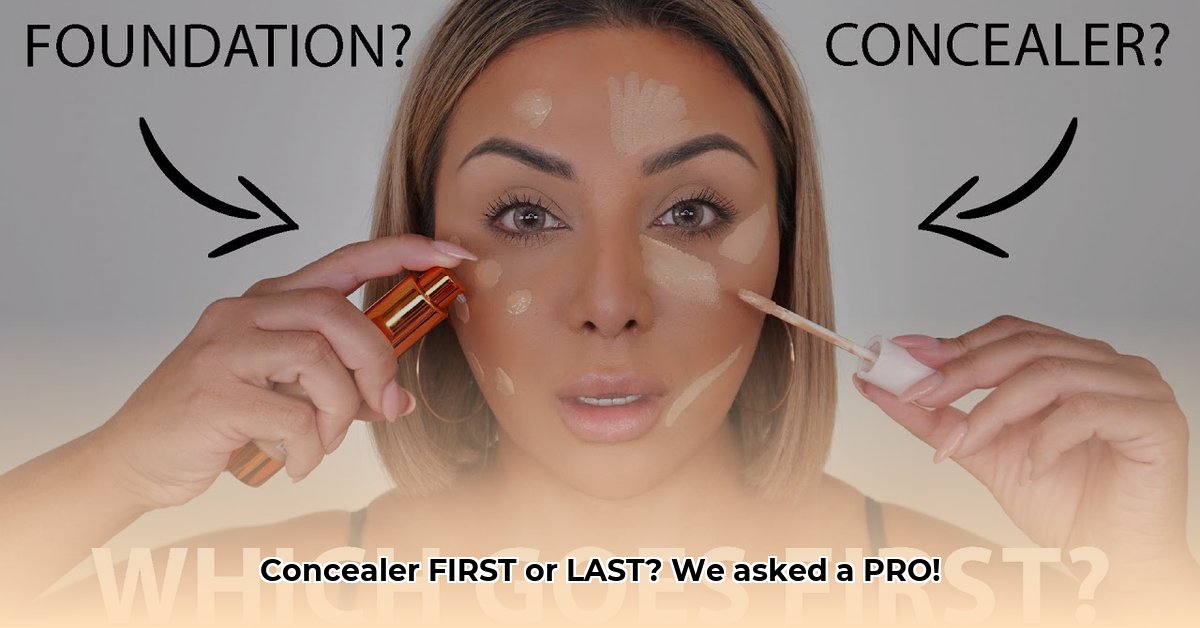So, you’re standing in front of your mirror with your foundation and concealer, wondering which one goes on first? It’s a classic makeup conundrum, and you’re not alone! The good news is, there’s no single “right” answer. It all comes down to your skin type, the look you’re going for, and the specific products you’re using. This guide will walk you through both methods, helping you achieve a flawless finish every time.
Method 1: Foundation First – The Classic Approach
This method is like creating a smooth canvas before painting. Applying foundation first creates an even base, minimizing the amount of concealer you’ll need. This often results in a more natural, “your skin but better” finish.
- Prime Time: Prep your skin with a primer. This is like the base coat for your makeup, smoothing out texture and helping your foundation last longer.
- Foundation Application: Apply your foundation as usual, blending it evenly into your skin.
- Conceal Strategically: After foundation, assess your skin. Do you see any blemishes, redness, or dark circles peeking through? Dab concealer on these areas and blend gently for seamless coverage.
- Set It and Forget It: A light dusting of setting powder locks your makeup in place, preventing shine and creasing.
3 Perks of Applying Foundation First:
- Natural Finish: This method often creates a more natural, skin-like look.
- Less Product: You’ll likely use less concealer, minimizing cakiness.
- Time-Saver: Foundation first can be a quicker routine.
Best For: Everyday makeup, natural looks, minimizing redness and discoloration, and those who prefer lighter coverage.
Method 2: Concealer First – The Targeted Approach
This method focuses on spot-treating imperfections before applying foundation. If you have prominent dark circles, blemishes, or hyperpigmentation, concealer first may provide the coverage you need.
- Prime Time (Always!): Primer is crucial, regardless of the method you choose.
- Conceal and Correct: Apply concealer directly to imperfections. You can also use color correctors at this stage. For example, peach or orange can neutralize dark circles, while green counteracts redness.
- Blend Seamlessly: Gently blend the concealer into your skin for a smooth transition.
- Foundation Application: Now, apply your foundation over the concealed areas, blending carefully to create a unified look.
- Second Concealer (Optional): If needed, you can add another thin layer of concealer after foundation for extra coverage.
- Set for Perfection: Finish with setting powder to lock in your makeup.
4 Reasons to Try Concealer First:
- Maximum Coverage: This method delivers targeted coverage for stubborn imperfections.
- Color Correction Power: Concealer first maximizes the impact of color correctors.
- Bright Under-Eyes: This technique can significantly brighten the under-eye area.
- Long-Lasting: Some individuals with oily skin find this method prevents makeup from sliding throughout the day.
Best For: Full-coverage makeup, color correcting, covering prominent imperfections, special occasions, and photography or videography.
Foundation First vs. Concealer First: A Quick Comparison
| Feature | Foundation First | Concealer First |
|---|---|---|
| Coverage | Buildable, Medium | Full, Targeted |
| Finish | Natural | Flawless, Can be heavier |
| Best For | Everyday makeup, Natural looks | Special occasions, Full coverage |
5 Factors That Influence the Best Method
- Skin Type: Dry skin may benefit from concealer first for targeted hydration. Oily skin may prefer foundation first to control shine. Combination skin might need elements of both!
- Concealer Formula: Thicker concealers may work better applied first, while liquids may blend seamlessly under foundation.
- Foundation Formula: A sheer foundation paired with concealer first may not provide adequate coverage.
- Desired Finish: Foundation first often yields a more natural finish. Concealer first is ideal for a full-glam, flawless effect.
- Specific Concerns: Minor imperfections may only require foundation first. Prominent concerns likely benefit from the targeted approach of concealer first.
A Word on Ongoing Research and Trends
The makeup world is ever-evolving. Some artists suggest concealer first can surprisingly lead to less product usage overall, while others emphasize blending technique over application order. Ongoing research will likely continue to refine these techniques.
FAQ
- What if my concealer and foundation are different shades? Ideally, concealer should match your skin tone. Foundation helps blend any slight shade variations. You can also mix a tiny drop of foundation into your concealer.
- Can I use both methods together? Absolutely! You can apply concealer first to targeted areas and then follow with foundation for overall coverage. Experiment to see what works best for your individual needs.
- What type of concealer should I choose? Liquid concealer tends to provide lighter coverage and works well for the under-eye area. Creamy and stick concealers offer heavier coverage for blemishes and discoloration.
Embrace the Experiment!
Ultimately, the best way to determine which method suits you is to experiment! Play with both techniques, considering your skin type, desired look, and product formulas. Makeup is about self-expression, so have fun with it! Try both and see which one makes you feel your most confident and beautiful.
- Wellness Fair Ideas for Work to Boost Employee Wellbeing - December 15, 2025
- Affordable Employee Wellness Fair Ideas for Any Budget - December 14, 2025
- Employee Wellness Programs Strategically Benefit Employee Health And Retention - December 13, 2025
















